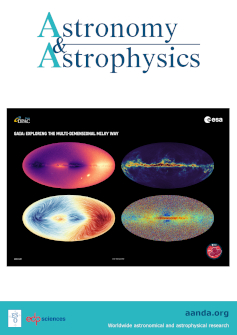Gas, not dust: Migration of TESS/Gaia hot Jupiters possibly halted by the magnetospheres of protoplanetary disks
IF 5.4
2区 物理与天体物理
Q1 ASTRONOMY & ASTROPHYSICS
引用次数: 0
Abstract
Context. The presence of short-period (< 10 days) planets around main sequence (MS) stars has been associated either with the dust-destruction region or with the magnetospheric gas-truncation radius in the protoplanetary disks that surround them during the pre-MS phase. However, previous analyses have only considered low-mass FGK stars, making it difficult to disentangle the two scenarios.Aims. This exploratory study is aimed at testing whether it is the inner dust or gas disk driving the location of short-period, giant planets.Methods. By combining TESS and Gaia DR3 data, we identified a sample of 47 intermediate-mass (1.5−3 M⊙) MS stars hosting confirmed and firm candidate hot Jupiters. We compared their orbits with the rough position of the inner dust and gas disks, which are well separated around their Herbig stars precursors. We also made a comparison with the orbits of confirmed hot Jupiters around a similarly extracted TESS/Gaia sample of low-mass sources (0.5−1.5 M⊙).Results. The orbits of hot Jupiters around intermediate-mass stars tend to be closer to the central sources than the inner dust disk, most generally consistent with the small magnetospheric truncation radii typical of Herbig stars (≲5 R*). A similar study considering the low-mass stars alone has been less conclusive due to the similar spatial scales of their inner dust and gas disks (≳5 R*). However, considering the whole sample, we do not find the correlation between orbit sizes and stellar luminosities that is otherwise expected if the dust-destruction radius limits the hot Jupiters’ orbits. On the contrary, the comparative analysis reveals that such orbits tend to be closer to the stellar surface for intermediate-mass stars than for low-mass stars, with both being mostly consistent with the rough sizes of the corresponding magnetospheres.Conclusion. Our results suggest that the inner gas (ad not the dust) disk limits the innermost orbits of hot Jupiters around intermediate-mass stars. These findings also provide tentative support to previous works that have claimed this is indeed the case for low-mass sources. We propose that hot Jupiters could be explained via a combination of the core-accretion paradigm and migration up to the gas-truncation radius, which may be responsible for halting inward migration regardless of the stellar mass regime. Larger samples of intermediate-mass stars with hot Jupiters are necessary to confirm our hypothesis, which implies that massive Herbig stars without magnetospheres (> 3−4 M⊙) may be the most efficient in swallowing their newborn planets.气体而非尘埃TESS/Gaia热木星的迁移可能因原行星盘的磁层而停止
背景主序星周围存在短周期(小于10天)行星,这与主序星前期的尘埃毁灭区或其周围原行星盘的磁层气体截断半径有关。然而,之前的分析只考虑了低质量的FGK恒星,因此很难将这两种情况区分开来。这项探索性研究旨在检验是内部尘埃还是气体盘驱动了短周期巨行星的位置。通过结合TESS和盖亚DR3数据,我们确定了47颗中质量(1.5-3 M⊙)MS恒星的样本,这些恒星寄存着确认的热木星和确定的候选热木星。我们将它们的轨道与内部尘埃和气体盘的大致位置进行了比较,后者在赫比格星前身周围被很好地分离开来。我们还将这些热木星的轨道与 TESS/Gaia 低质量星源(0.5-1.5 M⊙)样本中已确认热木星的轨道进行了比较。中质量恒星周围的热木星轨道往往比内部尘埃盘更靠近中心源,这与赫比格恒星典型的小磁层截断半径(≲5 R*)基本一致。由于低质量恒星内部尘埃和气体盘的空间尺度相似(≳5 R*),因此仅考虑低质量恒星的类似研究并不那么有说服力。然而,从整个样本来看,我们并没有发现轨道大小与恒星亮度之间的相关性,而如果尘埃破坏半径限制了热木星的轨道,那么这种相关性就会出现。相反,对比分析表明,中等质量恒星的热木星轨道往往比低质量恒星更接近恒星表面,两者与相应磁层的粗略大小基本一致。我们的研究结果表明,内部气体(而非尘埃)盘限制了中质量恒星周围热木星的最内侧轨道。这些发现也为以前的研究提供了初步支持,以前的研究声称低质量星源确实存在这种情况。我们提出,热木星可以通过内核增生范式和迁移至气体截断半径来解释,无论恒星质量如何,内核增生范式都可能是停止内迁的原因。这意味着没有磁层的大质量赫比格恒星(> 3-4 M⊙)在吞噬新生行星方面可能是最有效的。
本文章由计算机程序翻译,如有差异,请以英文原文为准。
求助全文
约1分钟内获得全文
求助全文
来源期刊

Astronomy & Astrophysics
地学天文-天文与天体物理
CiteScore
10.20
自引率
27.70%
发文量
2105
审稿时长
1-2 weeks
期刊介绍:
Astronomy & Astrophysics is an international Journal that publishes papers on all aspects of astronomy and astrophysics (theoretical, observational, and instrumental) independently of the techniques used to obtain the results.
 求助内容:
求助内容: 应助结果提醒方式:
应助结果提醒方式:


